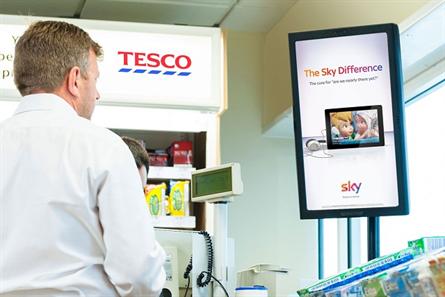Of Course Gas Stations Will Use Facial Recognition Tech to Serve 'Relevant' Ads
Because who hasn't seen Minority Report, right?

Say you're at a gas station. Say you're buying some supplies—bottled water, coffee, maybe some M&Ms—before you head back to your car. And as you're buying your loot, an ad pops up on a screen next to the cash register: it is really relevant to you. Like, really relevant.
It could be because of luck, but it could also be because the screen has sensed your age and your gender. Tesco, the U.K. supermarket chain, has just announced that it will be installing screens with facial recognition capabilities in 450 of its gas stations, reaching some 5 million customers. The purpose? To serve ads that are tailored to those customers' particular demographics.
"It's like something out of Minority Report," Simon Sugar, CEO of Amscreen, the company that provides the ad-targeting technology, declared of the system.
Except, of course, it's no longer just like something out of Minority Report. It's also like something out of the world we live in, every day. (Sugar: "This could change the face of British retail, and our plans are to expand the screens into as many supermarkets as possible.") Facial recognition systems may still unsettle us, in that they transform the most visually expressive aspects of ourselves—our faces—into data. But they are here. Their uses will likely only expand.
Facial recognition technology, at this point, is used for administrative purposes (the State Department, for example, uses it to process visa applications). It has been used for crime prevention purposes. It has been used for social engineering purposes, as in Facebook's numerous attempts to employ the technology in its photo-tagging systems. But the use that has perhaps the most potential for innovation is the one being experimented with in Tesco stores throughout the U.K. Facial recognition lets you target ads based on crude demographic indicators—which are crude, to be sure, but better, if you're an advertiser, than nothing. So it's no wonder that marketers have long been putting it to use in their messaging strategies. Here, largely via AdAge, is an extremely incomplete list:
Almax's "Eye See" Mannequins
The Italian company Almax brought facial recognition technology to the retail space via "seeing" mannequins. The inanimate models' built-in cameras captured images of storegoers, gathering, in the process, demographic information like age, gender, and race.
Coke Zero's Facial Profiler
In 2009, Coke Zero launched a Facebook app that promised to match people up with their lookalikes on the social network. Other users could vote on the quality of the likeness, which helped spread the campaign and refine the recognition technology at the same time.
Jell-O's "Temptations" campaign
In 2011, as part of its "adults only" campaign for its "Temptations" line, Jell-O placed kiosks outfitted with facial-recognition-enabled screens in Chicago’s Shedd Aquarium. If the computers detected that a viewer was an adult, the viewer received a free sample; kids, on the other hand, were rejected on the grounds that "you're too young to appreciate indulgence like this."
Nike's "Free Face"
In 2012, to promote the ultra-flexible Nike Free shoe, Nike released the Free Face video campaign. With it, a campaign summary notes, "you could bend, twist and contort its trademark sole using the power of your face."
Plan U.K.'s "Because I'm a Girl" ad campaign
When the British charity Plan U.K. launched its "Because I'm a Girl" campaign, it used facial recognition technology to create ads that would be targeted to the genders of the viewers. (The idea—which was also a commentary on empowerment and privation—was that only women would be allowed to see the full 40-second ad.)
Volkswagen's "Stop Start" video
To promote its technology, which turns the car's engine off when it's stationary, the carmaker created a Chrome app that stops Youtube videos when when the viewer looks away from them.
Earlier this year, Virgin Mobile USA released an interactive Youtube video. The catch? You could change the scenes in the video simply by blinking. The video combined 25 different films, AdAge notes, "leading to a total of more than two million different combinations."
These ads are notable, in large part, in that they treat facial recognition capabilities not as means to data-gathering, but as ends in themselves. They focus on fun and quirk, on the amusing serendipity that can result when you interact with a computer using not your finger, but your face. Tesco's adaptation of the technology to a more utilitarian purpose—targeting customers, rather than delighting them—suggests the other side of the technology: the side that has more in common with stores' efforts to mine customers' phone data using wifi signals. The side that makes you wonder where the line really is between selling to customers ... and selling them out.